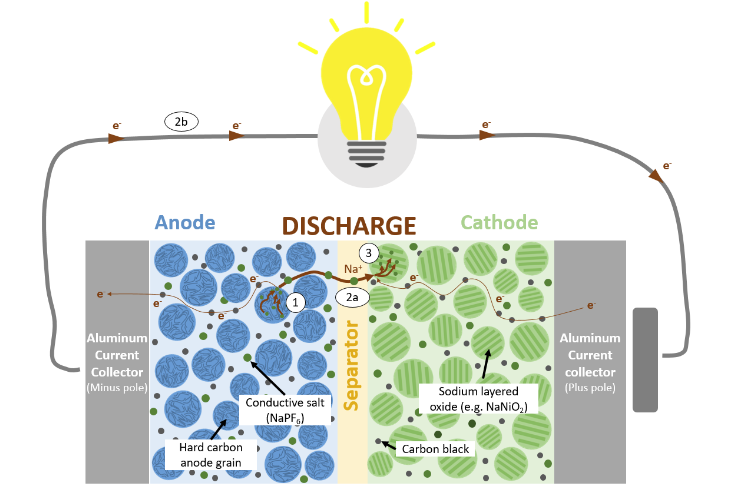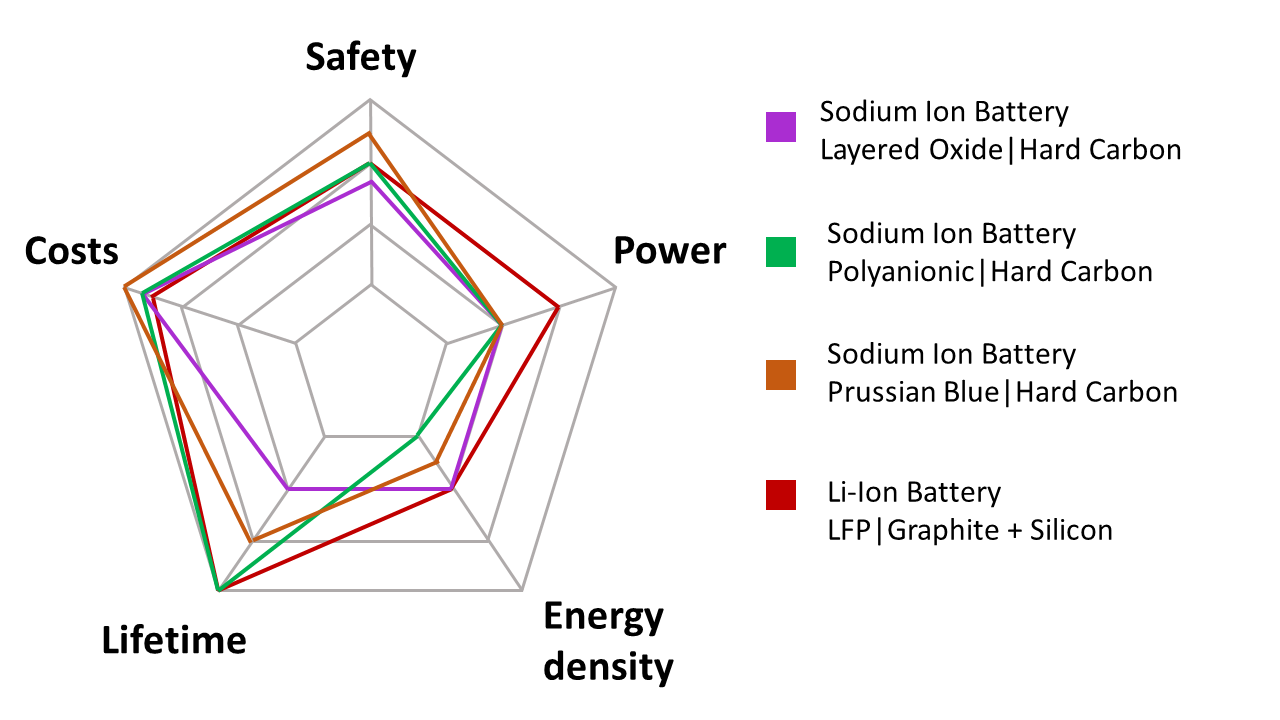With the increasing global demand for renewable energy sources and decreasing fossil fuel reserves, the development of efficient, low-cost, and safe energy storage technologies has become an urgent issue. Sodium-ion batteries (SIBs) show great potential for large-scale energy storage applications due to their abundant sodium resources and low production costs. Sodium-ion batteries (SIBs) not only inherit many of the advantages of lithium-ion batteries, but also overcome the problems of lithium resource shortage and high cost. However, SIBs still face many challenges when used in a wide range of temperatures. In this paper, the design principles, failure mechanisms, basic chemistry and safety issues of sodium-ion batteries will be described in detail.
The working principle of sodium-ion batteries is similar to that of lithium-ion batteries, which is based on the insertion/demergence process of sodium ions between the positive and negative electrodes to realize the storage and release of electrical energy. It mainly includes the following steps:
Charging process: under the action of an applied electric field, sodium ions are de-embedded from the positive electrode material (e.g., layered oxides or polyanionic compounds), migrate to the negative electrode (e.g., hard carbon, sodium titanate, etc.) through the electrolyte, and are embedded in the negative electrode material. At the same time, electrons flow from the positive electrode to the negative electrode through an external circuit.
Discharge process: sodium ions are de-embedded from the negative electrode material and migrate back to the positive electrode through the electrolyte, while electrons flow back to the positive electrode through the external circuit, releasing electrical energy.
The positive and negative reactions of a sodium ion battery determine the electrochemical performance and energy density of the battery. Typical positive and negative reactions are as follows:
Positive electrode reaction (NaFePO4 as an example):
NaFePO4 ↔ FePO4 + Na+ + e-
Negative electrode reaction (in the case of hard carbon):
C+Na+ + e- ↔ NaC
The reversibility and stability of these reactions directly affect the charging and discharging efficiency and cycle life of the battery.

Figure 1. Example of the chemical structure of a sodium ion battery (Cathode: layered oxide, anode: hard carbon). Schematic diagram of the discharge process.
Although the basic working principles of sodium-ion and lithium-ion batteries are similar, there are some important differences between them in the ion de-embedding process, material selection and electrochemical properties:
Ionic radius and mass: sodium ions have a larger ionic radius (1.02 A) than lithium ions (0.76 A) and a heavier mass than lithium ions. This means that the migration rate and diffusion coefficient of sodium ions are lower, which may lead to inferior kinetics of sodium-ion batteries compared to lithium-ion batteries.
Electrode material selection: Due to the larger radius of sodium ions, some electrode materials suitable for lithium-ion batteries are not applicable to sodium-ion batteries. For example, graphite is not stable in sodium ion batteries, while hard carbon, oxides and polyanion compounds perform better in sodium ion batteries.
Voltage plateau: Sodium-ion batteries typically operate at lower voltages than lithium-ion batteries. This is due to the fact that the standard electrode potential of sodium (-2.71 V vs. SHE) is higher than that of lithium (-3.04 V vs. SHE), and therefore sodium-ion batteries have a lower energy density.
Electrolyte compatibility: The electrolyte system of sodium-ion batteries needs to be adapted to the characteristics of sodium ions, and sodium salts such as NaPF6 or NaClO4 are usually used, while LiPF6 is usually used as the electrolyte salt in lithium-ion batteries.
The performance of sodium-ion battery depends greatly on the choice of positive and negative electrode materials:
Positive electrode materials: common positive electrode materials for sodium ion batteries include layered oxides (e.g., NaCoO2, NaFeO2), polyanionic compounds (e.g., Na3V2(PO4)3, NaFePO4), and Prussian blue compounds. Ideal cathode materials should have high capacity, good cycling stability and low cost.
Anode materials: Hard carbon is currently the most commonly used anode material for sodium-ion batteries, with good cycling stability and moderate capacity. In addition, sodium titanate (NaTiO2), metallic sodium and alloys (e.g., Sn, Sb) have been widely studied with the aim of improving the energy density and multiplication performance of the battery.
Electrolyte plays a role in transferring sodium ions in sodium-ion batteries. Common types of electrolytes include liquid electrolytes, solid electrolytes and gel electrolytes:
Liquid electrolyte: usually consists of sodium salt (e.g., NaPF6, NaClO4) dissolved in an organic solvent (e.g., ethylene carbonate, propylene carbonate). Liquid electrolytes have high ionic conductivity, but suffer from flammability, volatility and poor safety.
Solid state electrolytes: These include oxide (e.g., Na-β-Al2O3), sulfide (e.g., Na3PS4), and polymer electrolytes. Solid electrolytes offer high safety and good mechanical strength, but have relatively low ionic conductivity.
Gel electrolytes: Gels are formed by adding polymers to liquid electrolytes, combining the high ionic conductivity of liquid electrolytes with the high safety of solid electrolytes.

Figure 2. Comparison of chemical properties of different sodium ions
During repeated sodium ion embedding/de-embedding, the lattice structure of the electrode material will change, resulting in mechanical stress and volume change of the material, triggering particle rupture and active material detachment, reducing the capacity and cycle life of the battery. Meanwhile, the electrode/electrolyte interface is one of the key factors affecting the performance of sodium-ion batteries. During the cycling process, a passivation layer (e.g., solid electrolyte interface layer SEI) is easily formed at the interface, leading to an increase in the interfacial impedance, which affects ion transport and battery performance. An ideal SEI layer should have high ionic conductivity, good chemical stability and mechanical strength to protect the electrode, prevent further decomposition of the electrolyte and regulate ion transport.
In sodium metal negative electrodes, the deposition process of sodium ions may lead to the formation of sodium dendrites, which can seriously puncture the diaphragm and cause short circuit and safety problems. The formation of sodium dendrites is mainly influenced by the current density, the surface condition of the anode and the composition of the electrolyte. Methods to solve the sodium dendrite problem include optimizing the current density, improving the surface structure of the anode material and introducing functional electrolyte additives.
Liquid electrolytes will degrade during prolonged use, and the generated by-products may react with the electrode materials and affect the performance of the battery. For example, carbonate solvents are prone to decompose and generate gases under high voltage, leading to battery swelling and leakage problems. Although solid electrolytes perform better in terms of chemical stability, they have poor interfacial contact with electrode materials, leading to increased interfacial impedance and affecting battery performance. An ideal electrolyte should have a high sodium ion conductivity and a wide electrochemical stabilization window. Common electrolytes and their conductive mechanisms include: liquid electrolytes: migration by solvation of sodium ions under the action of an electric field. Solid electrolytes: conduct sodium ions through ion channels in the lattice, such as the oxygen ion vacancy migration mechanism in Na-β-Al2O3. Gel electrolytes: combining liquid electrolytes and solid substrates to form a flexible structure and improve ionic conductivity.
Thermal runaway is one of the most serious safety issues for sodium ion batteries in high temperature environments. High temperatures can lead to electrolyte decomposition, electrode material reaction intensification and SEI layer failure, generating a large amount of heat and gas, triggering battery fire and explosion. Measures to prevent thermal runaway include:
Thermal management system: Introducing efficient thermal management systems, such as phase change materials (PCM) and high thermal conductivity materials, into the battery design to dissipate heat quickly and keep the battery operating within a safe temperature range.
Fire protection design: Incorporate fire-resistant compartments and flame-retardant materials, such as fire-resistant barrier films, into the battery module to reduce the risk of fire.
Thermal runaway inhibitors: Add thermal runaway inhibitors, such as phosphate ester compounds, to the electrolyte to improve the thermal stability of the electrolyte and reduce the occurrence of decomposition and side reactions.
The formation of sodium dendrites not only affects the battery performance, but also may puncture the diaphragm, triggering short circuits and safety issues. Measures to prevent sodium dendrite formation include:
Optimize the current density: During the charging process, control the reasonable current density to reduce the formation of sodium dendrite.
Improve the surface structure of negative electrode material: improve the uniformity of the surface of negative electrode material through surface modification and nanostructure design to reduce the growth of dendrite.
Functional electrolyte additives: introduce functional electrolyte additives, such as ionic liquids and SEI film-forming additives, to regulate the deposition behavior of sodium ions and inhibit the formation of dendrites.
Leakage of liquid electrolyte is one of the safety hazards faced by sodium-ion batteries in practical applications. Leakage of electrolyte not only leads to degradation of battery performance, but also may cause short circuit and fire. Methods to prevent electrolyte leakage include:
Sealing design: Use high-strength sealing materials and structures in battery design to prevent electrolyte leakage.
Solid electrolyte replacement: Use solid electrolyte instead of liquid electrolyte to eliminate the risk of leakage and improve the safety of the battery.
Sodium-ion batteries have a broad application prospect in the field of energy storage, but many technical challenges still need to be solved before realizing their wide application.
Continuous exploration of new electrode materials and electrolyte materials, especially those with wide temperature stability, is the key to improving the performance of sodium-ion batteries. For example, research on polymer electrolytes and nanocomposites with self-healing function is expected to provide higher electrochemical performance and stability under wide temperature conditions.
Further research and optimization of the stability and ion transport efficiency of the electrode/electrolyte interface is an important direction to enhance the overall performance of the battery. The formation of low impedance and high stability interface through surface modification and interface modification is an important topic for future research.
The application of sodium-ion batteries in actual energy storage systems requires consideration of the integration and optimization of the design of the battery pack. By optimizing the battery module design, thermal management system and safety protection measures, to ensure efficient and safe operation of the battery in a wide temperature range.
In the process of developing sodium-ion battery technology, its sustainability and economy need to be considered. For example, research on low-cost and environmentally friendly electrode materials and electrolytes, as well as efficient recycling and reuse technologies, is needed to reduce the production and use costs of sodium-ion batteries and improve their economic efficiency.
Sodium-ion batteries show great potential in the field of energy storage due to their abundant resources, low cost and good electrochemical performance. However, challenges in design principles, failure mechanisms, basic chemistry and safety issues still need to be addressed to realize the wide application of sodium-ion batteries. Through sustained research and technological innovation, the performance and safety of sodium-ion batteries can be significantly improved to promote their application in large-scale energy storage and electric transportation. Future research directions include the development of new materials, interface optimization and system integration, as well as sustainability and economic considerations. We look forward to promoting the development of sodium-ion battery technology through multidisciplinary cross-collaboration to realize the sustainable use of green energy.




The lab focuses on solid-state battery research to overcome traditional lithium batteries' safety and energy density issues, supporting environmental sustainability. It develops innovative solid-state electrolytes, refines electrode materials, and investigates ion transfer and interface stability to revolutionize battery technology.

The electric vehicle battery industry is rapidly developing, focusing on technological innovation, market competition, and sustainability. Research hotspots include solid-state batteries, new types of electrolytes, BMS optimization, and recycling technologies. The environmental adaptability, safety, and economic viability of batteries are key research areas, and the industry is expected to undergo more innovation and transformation.

Specializing in battery preparation technology research, the focus is on overcoming existing energy storage challenges by innovating in electrode materials, battery chemistry, and manufacturing processes to improve performance, safety, and reduce costs. Sustainability and recycling technologies for batteries are also emphasized to mitigate environmental impacts and foster the growth of green energy.